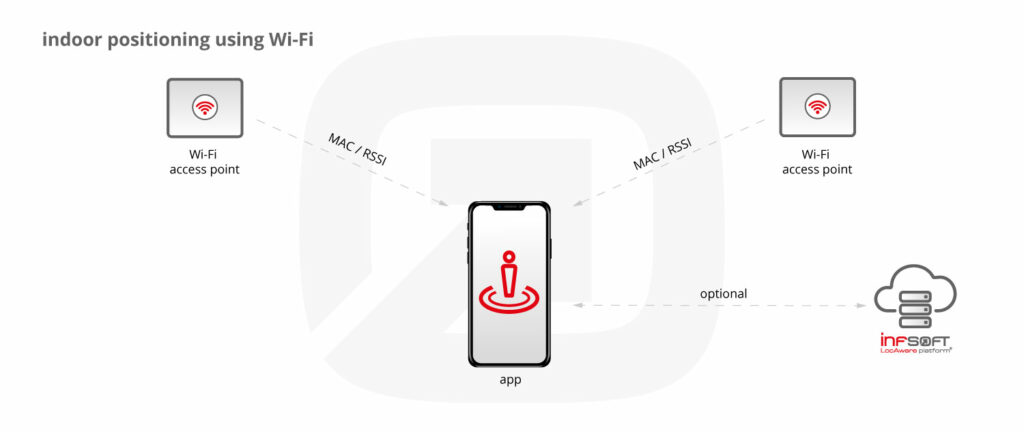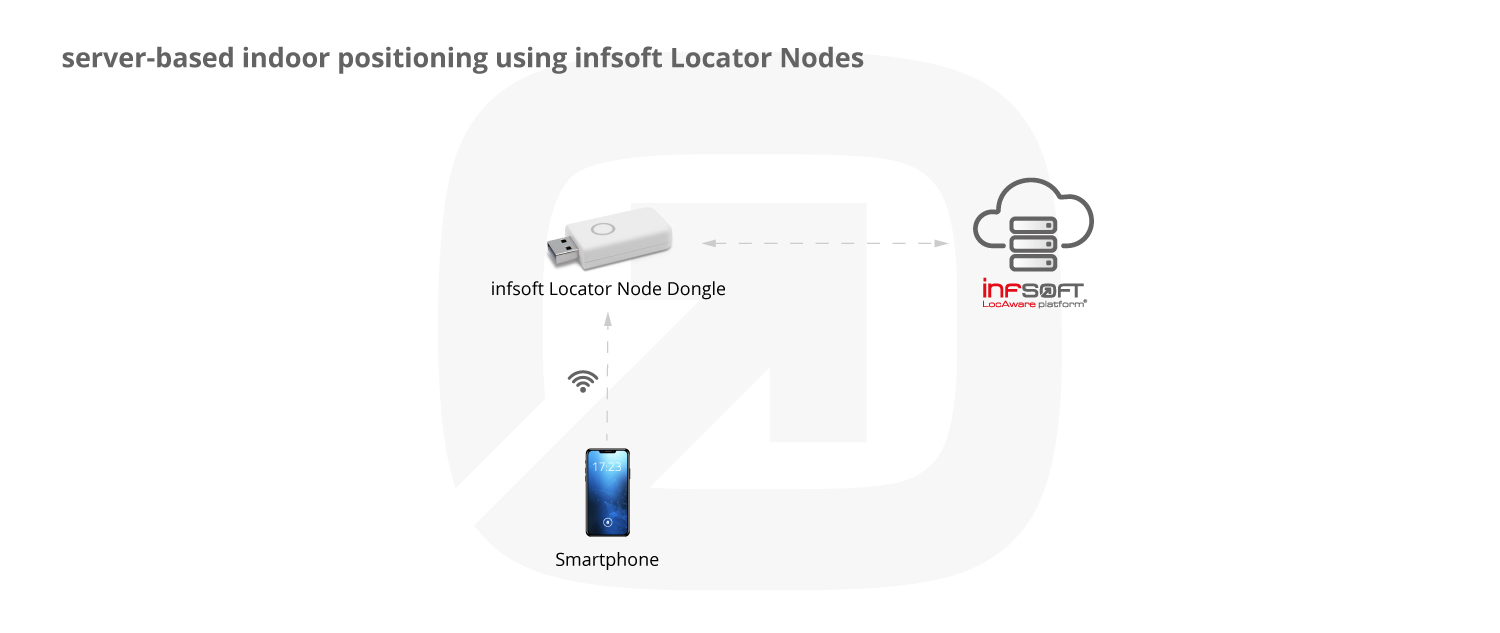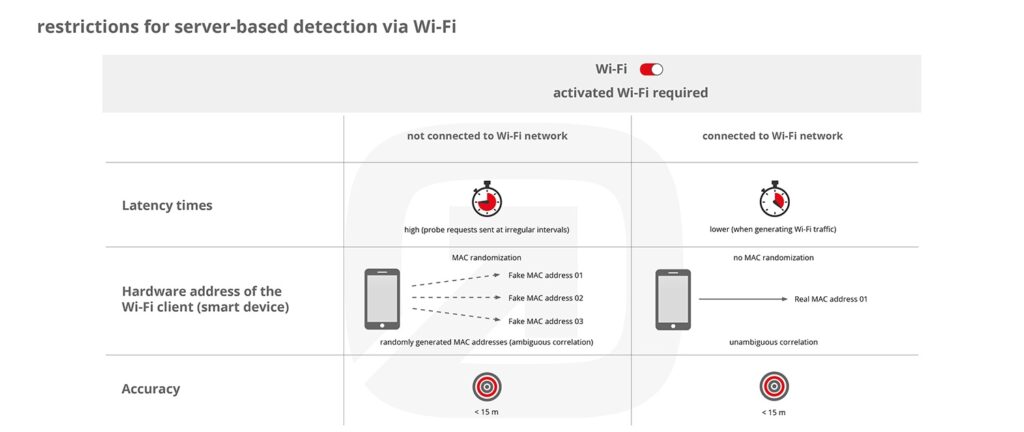Indoor Positioning, Tracking and Indoor Navigation with Wi-Fi
Wi-Fi positioning can be applied for indoor navigation (client-based solution) as well as for tracking solutions (server-based approach). The accuracy of Wi-Fi for indoor positioning is typically 5-15 meters because access points are usually used whose position has been optimized for data communication. This precision depends on the shielding through walls, ceilings and people, as well as the number of access points. The use of smartphone sensors can improve the results and the determination of the floor level is also possible.
Advantages of this technology are that the existing infrastructure can be used in some cases and that enabled Wi-Fi is sufficient when devices are located, a login is not required. The weaknesses are a lower positioning accuracy compared to Bluetooth Low Energy and the fact that iOS devices are excluded from client-based positioning. Moreover, Wi-Fi Tags are more expensive and less energy-efficient compared to beacons.
Client-Based Approach
Using a client-based solution, the localization takes place directly in an app on the end device. This approach is most commonly used for indoor navigation. The data can optionally be forwarded to the backend where it can be made available for analysis purposes.
Each Wi-Fi access point, whether customer hotspot, router or Internet-capable point of sale system, transmits specific data. Using a RSSI (Received Signal Strength Indication) and MAC address (Media Access Control), an app can calculate the current location of the end user device. This requires a database with information about the locations with which this data can be compared. This method is called fingerprinting. Due to technical restrictions, iOS devices cannot be used for Wi-Fi client-based indoor positioning.
Server-Based Approach
A server-based solution is implemented when the purpose of the indoor positioning is to track assets or analyze walking routes, for example. The system can be set up in different ways. In some application scenarios, the localization can be based on existing Wi-Fi infrastructure, while for other positioning projects, a complete solution with infsoft infrastructure hardware is the best choice.
However, compared to indoor positioning using Bluetooth Low Energy (BLE) beacons, localization using Wi-Fi is subject to a number of limitations. These include the comparatively inaccurate position resolution, the low battery life and the high cost of Wi-Fi tags. In many cases, localization with BLE is therefore the best solution.
There are two setups that enable Wi-Fi positioning based on an existing infrastructure. To realize this, mobile Wi-Fi tags can be attached to assets or are worn by people in the form of wristbands.
In the first setup, smart Wi-Fi tags that act as a client are applied. The tag receives signals from multiple Wi-Fi access points and forwards the information via Wi-Fi to a backend. The position of the tag is determined based on RSSI (received signal strength indication). Using this setup, the logic for calculating the position is mapped directly on the Wi-Fi tag or in the backend. The existing Wi-Fi access points only transmit signals and there is no special configuration required.
In the second setup, smart access points with location engine are used. In this scenario, the logic mapping is performed at access point level. The access points receive the signals emitted by the mobile Wi-Fi tags and make the data available to the infrastructure provider’s location engine in order to calculate the position. Third-party providers can access the data via an interface.
However, in most cases the existing infrastructure isn’t sufficient for reliable localization with room accuracy and the infrastructure extension (additional supported access points, location engine of the access point provider) can be cost-intensive. Therefore, the acquisition of a complete solution by infsoft provides a good alternative.
With infsoft’s own receiver hardware – the infsoft Locator Node Dongle – the location of Wi-Fi tags and Wi-Fi enabled devices, independent of the manufacturer, can be determined. This solution requires the installation of infsoft Locator Nodes at regular intervals throughout the building. The hardware then receives signals of mobile devices carried by people and Wi-Fi tags which can be attached to assets. The data is then sent to the backend where the position is determined.
General Restrictions when Tracking Mobile Devices Using Wi-Fi
Depending on whether the device is connected to a Wi-Fi network or not, localization is affected by various restrictions. If the Wi-Fi client is not connected, latency times of up to 5 minutes result from the irregular sending of “probe request” (scanning for available access points), which is controlled by the mobile operating system and cannot be influenced. In addition, due to randomly generated, changing MAC addresses (“MAC randomization”), the smart device or the actual number of devices in an area cannot always be determined unambiguously. If the smartphone is connected to a Wi-Fi network, latency times are significantly lower as long as traffic is generated over the network. In addition, there is no MAC randomization, which means that the device can be uniquely assigned. The position accuracy is not affected by the connection to an access point.







